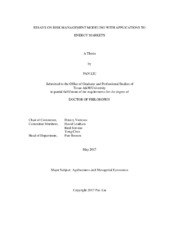| dc.contributor.advisor | Vedenov, Dmitry | |
| dc.creator | Liu, Pan | |
| dc.date.accessioned | 2017-08-21T14:41:39Z | |
| dc.date.available | 2019-05-01T06:07:11Z | |
| dc.date.created | 2017-05 | |
| dc.date.issued | 2017-04-24 | |
| dc.date.submitted | May 2017 | |
| dc.identifier.uri | https://hdl.handle.net/1969.1/161525 | |
| dc.description.abstract | The dissertation consists of three essays, addressing different aspects of risk management in multi-commodity setting with application to energy markets.
The effectiveness of traditional and alternative hedging strategies during the period of volatile oil price is analyzed. Minimization of downside risk (LPM2) and variance are used as alternative hedging objectives. The joint distribution of spot and futures price log returns is modeled using a kernel copula method. The results show that allowing for arbitrary proportions in the sizes of futures positions generally achieves a better hedging performance. The advantage becomes particularly important during periods characterized by greater variation of the cross-dependence between the price log returns of individual commodities. In addition, using LPM2 as a hedging criterion can help hedgers to better track downside risk as well as lead to higher expected profit and lower expected shortfall.
The dynamics of WTI/Brent price spread is studied and how the spread responds to different types of physical market shocks is investigated. A test for structural breaks in the WTI/Brent price spread indicates a change from a stationary to a non-stationary time series in December 2010. The impact of physical market fundamentals on the dynamics of WTI/Brent price spread is then analyzed using a Structural Vector Autoregressive Model (SVAR). Impulse response functions generated from SVAR model show that the WTI/Brent spread is mainly driven by the U.S. production and U.S. business activity shocks.
The dynamics of correlation structure and volatility transmission mechanism between crude oil futures and stock market at both aggregate and individual sector levels are analyzed. We find that the dynamic conditional correlation between crude oil and stock market increased sharply during the 2008-2009 financial crisis. Volatility spillover analysis show that Financials (XLF) and Technology (XLK) sectors are the two strongest volatility transmitters. The roles of crude oil and S&P500 index as transmitters or receivers is highly dependent on the market condition, namely, crude oil’s volatility transmission impact is larger when its price is higher and S&P500 is more likely to be “receiving” volatility when the stock market is in crisis. | en |
| dc.format.mimetype | application/pdf | |
| dc.language.iso | en | |
| dc.subject | Risk | en |
| dc.subject | Energy Market | en |
| dc.title | Essays on Risk Management Modeling with Applications to Energy Markets | en |
| dc.type | Thesis | en |
| thesis.degree.department | Agricultural Economics | en |
| thesis.degree.discipline | Agribusiness and Managerial Economics | en |
| thesis.degree.grantor | Texas A & M University | en |
| thesis.degree.name | Doctor of Philosophy | en |
| thesis.degree.level | Doctoral | en |
| dc.contributor.committeeMember | Leatham, David | |
| dc.contributor.committeeMember | Stevens, Reid | |
| dc.contributor.committeeMember | Chen, Yong | |
| dc.type.material | text | en |
| dc.date.updated | 2017-08-21T14:41:40Z | |
| local.embargo.terms | 2019-05-01 | |
| local.etdauthor.orcid | 0000-0002-1222-4648 | |


